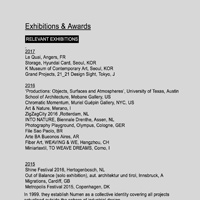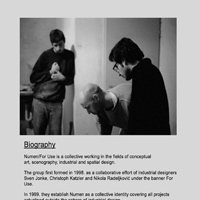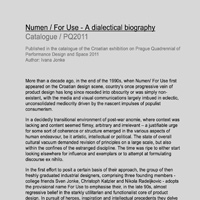Published in the catalogue of the Croatian exhibition on Prague Quadrennial of Performance Design and Space 2011
Author: Ivana Jonke
More than a decade ago, in the end of the 1990s, when Numen/ For Use first appeared on the Croatian design scene, country's once progressive vein of product design has long since receded into obscurity or was simply non-existent, with the media and visual communications largely imbued in eclectic, unconsolidated mediocrity driven by the nascent impulses of populist consumerism.
In a decidedly transitional environment of post-war anomie, where context was lacking and content seemed flimsy, arbitrary and irrelevant – a justifiable urge for some sort of coherence or structure emerged in the various aspects of human endeavour, be it artistic, intellectual or political. The state of overall cultural vacuum demanded revision of principles on a large scale, but also within the confines of the estranged discipline. The time was ripe to either start looking elsewhere for influence and exemplars or to attempt at formulating discourse ex nihilo.
In the first effort to posit a certain basis of their approach, the group of then freshly graduated industrial designers, comprising three founding members - college friends Sven Jonke, Christoph Katzler and Nikola Radeljkovic - adopts the provisional name For Use to emphasise their, in the late 90s, almost regressive belief in the starkly utilitarian and functionalist core of product design. In pursuit of heroes, inspiration and intellectual precedents they delve deep into the first half of the departing century, towards the old canons of Bauhaus, Malevich, Russian constructivism and European abstract and concrete art but also into post war America, with its exotic fruit of wild frontier essentialism, conceptual art, Sol LeWitt, James Turrell, Mies Van Der Rohe and Rothko.
From 1999, and parallel to the already thriving For Use furniture design commissions in Italy, the collective starts to engage, through their copious street connections, with Zagreb underground club and art scene, staging and art-directing various public projects, from exhibitions and trade-fair events to club nights and parties. At the time the group broadens its membership to incorporate two graphic designers - friends and accomplices Jelenko Hercog and Toni Uroda, morphing through this expansion into a proper interdisciplinary design unit. The entire fellowship continues to operate as a tightly knit community of mutually corrective enthusiasts, who share both work space and living space, while disclosing the manner, lifestyle and fanaticism of a guerrilla brigade.
Prior to the opening of the 34th Zagreb Salon in 1999, whose setup and art-direction was the group’s first total design project – to somehow distinguish this part of their activity, from the “For Use” signed work in industrial design, they come up with a new nom de guerre to be added to the current title: Numen.
Numen (noumenon) is a word derived from the Kantian Theory of Knowledge signifying a thing viewed as a purely transcendental object. Kant posits that objects must exist as the unfathomable, presumed «things-in-themselves» (noumena), separate and independent of the senses, before they can be manifested as appearances (phenomena), which constitute experience. Pure forms acquired through perception and pure concepts delivered by reason are here useless, since they give a systematic view of only the phenomenal, experiential realm but reveal nothing of the noumenal realm which is by definition unknowable and thus forever given over to metaphysics. Noumenon is hence the eternally latent reality of an object, a total and absolute existence of an object; an ideal form of which every phenomenon is merely a Platonian shadow.
The point the group tried to advance, relying theoretically on the legacy of German transcendental idealism, as well as on their own analysis of natural processes and living systems, was less about projecting something new into reality, but rather about revealing latent, pre-existing qualities in matter. Such approach cannot be written off as an elitist, transcendental undertaking, since it nurses, in its idealist folds, a fundamental obligation to redeem the world in which it acts, thus becoming ultimately concrete.
Reinvented as Numen/For Use, the group demonstrated their dual, bifurcated identity; the double-barreled name suitably reflecting the inner dialectics which was to become the paradigm and the driving force of their future work and method.
Winning the Grand Prix of the 34th Salon is perhaps the starting point of the first distinctive phase in the professional biography of the collective, a phase that lasted from 1999 until about 2003/4, when the joint focus begins to turn more directly towards the theatre.
This formative period, with its axiomatic purity and clear-eyed seriousness wrought from the driest distillate of visual and structural modernism, was fairly decisive in the development of the group ethos. Since the post-modern streak, dominating global visual culture of the time, left them largely unimpressed, or as Sven Jonke once summarised it: “There were no ideas around us. Just styling”, it was necessary to find other means of expression.
For Numen, the sober and honest cult of functionalist minimalism reigned paramount, with all attempts at inconsistent artism or impromptu solutions shunned and cut at the root. The accepted methodology favoured a clear line of causality, devoid of arbitrariness, uncertainty or chance. At this point the group sees in design process less an art or a technique and more a surgery upon phenomenal reality that must be performed with strict determination and a carefully sharpened scalpel. Tasks are never approached lightly but with exploratory rigour, cerebral control and grit, occasionally teetering on the verge of pedantry. Parellely, everyday objects made by carpenters and metal workers, but also various accidental and anonymous pieces, are marvelled at and studied in pursuit of coherent methods and the lost wisdom of techné.
According to early Numen postulates, design was primarily an affair of disciplined research and controlled ordering of phenomenological matter, which, by virtue of being purged of unnecessary metaphor and analogy, and through the act of revealing of its intrinsic, immanent logic, produces objects that contain a reflection of the ideal. This process is by nature reductive, hygienic and essentialist and prone to resolve itself in strong singular gestures which demand unspoiled attention and rule out superficial reading. Thus acquired condensed form usually resides on simple geometricism, underpinned by extended conceptual substructure or theoretical matrix, all of which serve to amplify its apparent content.
Resulting design is consistently minimalist to the level of being absent yet attaining total and disarming presence precisely through this reduction.
Another underlying, if speculative, aspect of Numen's austere and introspective approach was the will-to-enlighten, to uplift the masses from their eclectic stupor, to propel collective progress by re-setting design standards in the barely solidified social conditions of the turn of the century Croatia; a proper clandestine operation of would-be cultural deliverance which, on a certain level, must have fuelled the enthusiasm of everyone involved. When asked directly, Numen generally deny political positioning even in the broadest sense, yet any form of radicalism or ideological stance envisaging the re-design of the “world to come”, is, in the final instance, bound to have political connotations. It has indeed become a sort of cultural cliché to try to read into a design based on the principles of rationalization and functionality - a strategy and weapon of socio-political reform, yet in the case of Numen, a certain educative and revelatory attempt is clearly felt.
The initial, “heroic” phase in their biography was obviously a period of rigid and radical authorial profiling, marked by uncompromising juvenile force, zealotism and conviction, in which the group not only systematically approached design as a comprehensive process of scrutiny and reduction but also tried to advance its underrated discursive potential.
In order to address the apparent lack of structure and contextual influence, they turned back to re-analyse the very basics of the discipline. Form. Function. Clarity.
This was their design as manifesto or, rather, design as discourse; a totalizing universe, complete, bound and safely unmediated by difference, ephemerality or laughter.
Ascetic and puritanical in style, yet luxuriously elaborate in method, Numen were an undeniable novelty on the somewhat stale Croatian contemporary design scene.
When, after several years of a rewarding and fruitful production, the eliminative and territorialising force of the initial doctrine exhausted itself - its strict methodology now stiffened into an airless conceptual deadlock and blocking the lines of progress – it became clear the collective was ready for a reform. The ripening need for a new approach, an impulse to resist ossification and escape boredom, habituality and repetitiveness - is what marks the dawn of the second phase in the group's development. This phase sees Numen trying to break from the militancy of the former period and actualising this crucial schism through their involvement with the theatre . The fundamental shift is felt on all levels of production, be it stage design, industrial design or just general weltanschaung. The manifesto radicalism of the previous phase dissolved into more liberating, relaxed and self-assured pluralism. Work in the theatre thus served as a catalyst for a transcendence, for the coming of age, the growing up of the collective, now again consisting solely of three core members Jonke, Katzler and Radeljkovic, with active bases in Zagreb and Vienna. It seems as if the engagement with the theatre and the conceptual switch it brought about was a logical trajectory in the biography of a group whose earliest activities were already displaying an affinity towards scenographic experiments with manipulating space and objects, materialised foremostly through their gesamkunstwerk approach to staging public events. These served as a foreplay to what will eventually blossom into proper large-scale stage design projects, seeing it was only a matter of time and basic causality for the first offer from the theatre to land at their doorstep.
The inability to exert absolutist control over the total outcome, which accompanies work in theatrical production, the practical necessity of cooperation, imperfection and tolerance, as well as the transitory and fleeting nature of the eventual result, all served to soften the edges of the conceptual grid and open the group's ranks to the motley influx of extrinsic influence, dirt, hybridisation and chaos. With the controlling grip of puerile dogmatism finally loosened, the field of experimentation now lay ready for perusal by what was already a mature and consolidated discourse.
The new methodology placed more emphasis on the process than on the result, focussing on experiment rather than revelation, allowing bastardisations and overlapping of fields of activity, creating context where a chair can become a leitmotif for stage design, where objects expand into architecture and scenography turns into an installation. This disciplinary intermeshing, this interstitial space that opened between design, scenography, architecture and art became a great new playground for testing out singular methods on the expanding substratum of different media.
When discussing their methodology in hindsight, Numen like to point out the persistency of the inner dialectics entrenched at the root of the their production, which manifests itself through a constant concurrence of the impulse towards order and the compulsion to transgress and give themselves over to chaos. This internal tension is perhaps characteristic for the field of design or the applied arts yet in the case of Numen/For Use it embodies the crucial creative dynamics within the group - the very poles of which are reflected in their hyphenated name and geographical split.
An uneasy yet productive oscillation between the notions of art and function, poiesis and techné, matter and ideal, reduction and excess, design and theatre - is resolved through a process akin to Hegelian sublation, where both aspects of a dialectical exchange are subsequently overcome and preserved. In this story of unflinching advancement and constant dynamic movement towards unity, difference is turned into contradiction, contradiction into reconciliation and a biography into dialectical biography.
Being involved with neither just technical production nor with creation in the romantic sense, being by definition dialectical, Numen’s work attempts at reconciling thought with matter and zeitgeist, at bringing forth and materialising the undisclosed potential of the moment.
For Numen there are no unbeatable rules or ossified principles in either life or design, but a continuous research that is in itself developmental and generative, reflecting in its unfolding spiral the ultimate constancy of flux.
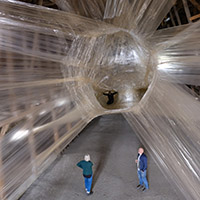 Tape WanåsWanås Konst Sculpture Park, Sweden 07.05 - 04.09.22
Tape WanåsWanås Konst Sculpture Park, Sweden 07.05 - 04.09.22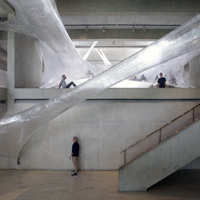 Tape Des MoinesDes Moines Art Centre, I. M. Pei Building / Drawing in Space, 28.09.2017.-21.01.2018
Tape Des MoinesDes Moines Art Centre, I. M. Pei Building / Drawing in Space, 28.09.2017.-21.01.2018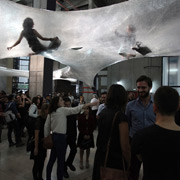 Tape ParisPalais de Tokyo / Inside, 20.10.14.-11.01.15.
Tape ParisPalais de Tokyo / Inside, 20.10.14.-11.01.15.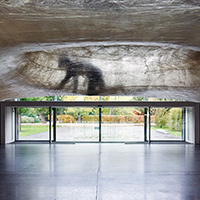 Tape MoscowGarage Museum of Contemporary Art, “The Coming World: Ecology as the New Politics 2030-2100”, 1.10.-1.12.2019
Tape MoscowGarage Museum of Contemporary Art, “The Coming World: Ecology as the New Politics 2030-2100”, 1.10.-1.12.2019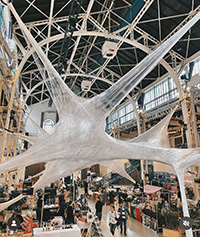 Tape BratislavaOld Market Hall, 01.06.-01.09.2023
Tape BratislavaOld Market Hall, 01.06.-01.09.2023 Tape Sao PauloCentro Cultural FIESP / File, 11.07.16.-28.08.16.
Tape Sao PauloCentro Cultural FIESP / File, 11.07.16.-28.08.16.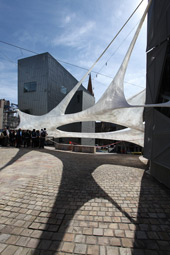 Tape MelbourneFederation Square 13. - 24.09.2011
Tape MelbourneFederation Square 13. - 24.09.2011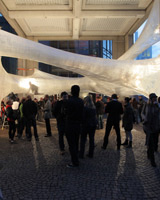 Tape FrankfurtSchirn Kunsthalle / 08.-17.09.2010 Frankfurt
Tape FrankfurtSchirn Kunsthalle / 08.-17.09.2010 Frankfurt Tape TokyoSpiral Garden 18.11. - 04.12.2013, Wacoal Art Center, Tokyo, Japan
Tape TokyoSpiral Garden 18.11. - 04.12.2013, Wacoal Art Center, Tokyo, Japan Tape HasseltHouse for Contemporary Art Z33 / 30.11.2012. Hasselt, Belgium
Tape HasseltHouse for Contemporary Art Z33 / 30.11.2012. Hasselt, Belgium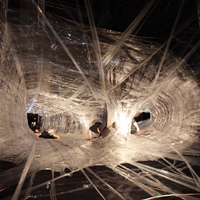 Tape Vienna / OdeonQuer / 10.-15.03.2010 Odeon, Vienna
Tape Vienna / OdeonQuer / 10.-15.03.2010 Odeon, Vienna Tape Vienna / AtticVienna Design Week / 01.-11.10.2009 Austria
Tape Vienna / AtticVienna Design Week / 01.-11.10.2009 Austria Tape ÖrebroOpen Art 2014, Örebro, Sweden
Tape ÖrebroOpen Art 2014, Örebro, Sweden Tape FlorencePalazzo Strozzi 30.04. - 20.05.2011
Tape FlorencePalazzo Strozzi 30.04. - 20.05.2011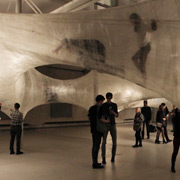 Tape StockholmFärgfabriken 04.02.-11.03.12
Tape StockholmFärgfabriken 04.02.-11.03.12 Tape BerlinInternational Design Festival DMY / 09.-13.06.2010 Airport Tempelhof, Berlin
Tape BerlinInternational Design Festival DMY / 09.-13.06.2010 Airport Tempelhof, Berlin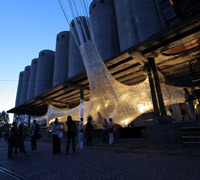 Tape Belgrade / MikserMikser Design Expo / 25.-29.05.2010 Belgrade
Tape Belgrade / MikserMikser Design Expo / 25.-29.05.2010 Belgrade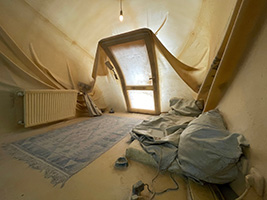 Negative Spaceaut. architektur und tirol, Innsbruck, 2023
Negative Spaceaut. architektur und tirol, Innsbruck, 2023 String ViennaVienna, 2014
String ViennaVienna, 2014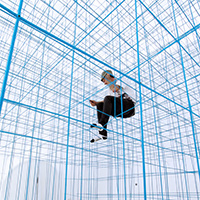 String BratislavaBiela noc, 27.- 29.09.2019, Bratislava, Slovakia
String BratislavaBiela noc, 27.- 29.09.2019, Bratislava, Slovakia String BerlinaquabitArt Gallery, 01.02.20.-31.03.20, Berlin, Germany
String BerlinaquabitArt Gallery, 01.02.20.-31.03.20, Berlin, Germany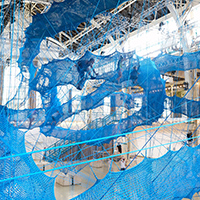 Tube BratislavaOld Market Hall, 23.06. - 31.08.2021
Tube BratislavaOld Market Hall, 23.06. - 31.08.2021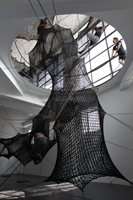 Tube Innsbruckaut. architektur und tirol 16.7.-10.10.15., Austria
Tube Innsbruckaut. architektur und tirol 16.7.-10.10.15., Austria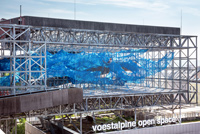 Tube LinzSinnesrausch, OK Center for Contemporary Art, Linz, 24. Mai – 13. Oktober 2019
Tube LinzSinnesrausch, OK Center for Contemporary Art, Linz, 24. Mai – 13. Oktober 2019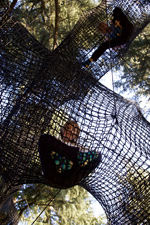 Tube MeranoArt & Nature, Walking with Senses 24.03. – 05.06.2016., South Tyrol, Italy
Tube MeranoArt & Nature, Walking with Senses 24.03. – 05.06.2016., South Tyrol, Italy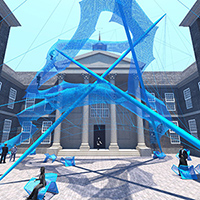 Tube SchiedamStedelijk Museum Schiedam 01.10.2021
Tube SchiedamStedelijk Museum Schiedam 01.10.2021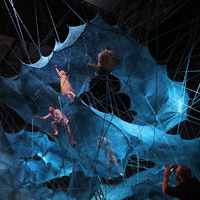 Tube CologneCarlswerk 16.09. - 09.10.2016
Tube CologneCarlswerk 16.09. - 09.10.2016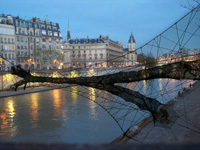 Tube ParisNuit Blanche 2016.
Tube ParisNuit Blanche 2016.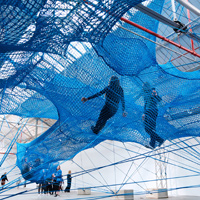 Tube LondonBrewer Street Car Park, 16.-19.02.1019.
Tube LondonBrewer Street Car Park, 16.-19.02.1019.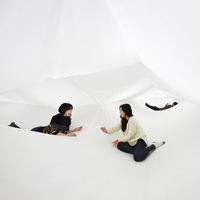 Void SeoulStorage, Hyundai Card, 24.03.-16.07.17., South Korea
Void SeoulStorage, Hyundai Card, 24.03.-16.07.17., South Korea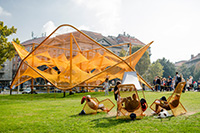 Net ProstoriaMeštrović Pavilion, Zagreb 25.09.-08.10.21
Net ProstoriaMeštrović Pavilion, Zagreb 25.09.-08.10.21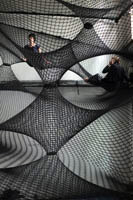 Net HasseltHouse for Contemporary Art Z33 / 02.07. - 02.10.2011 Hasselt, Belgium
Net HasseltHouse for Contemporary Art Z33 / 02.07. - 02.10.2011 Hasselt, Belgium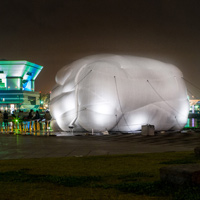 Net YokohamaZou-na-hanna terrace 21.-25.10.2013 Yokohama, Japan
Net YokohamaZou-na-hanna terrace 21.-25.10.2013 Yokohama, Japan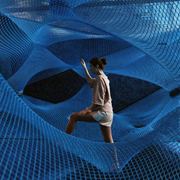 Net RovinjHotel Amarin 2016 Rovinj, Croatia
Net RovinjHotel Amarin 2016 Rovinj, Croatia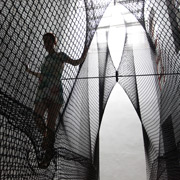 Net LinzOK Center for Contemporary Art / 27.06. – 19.10.2014 Linz, Austria
Net LinzOK Center for Contemporary Art / 27.06. – 19.10.2014 Linz, Austria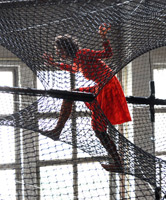 Net BerlinOpernwerkstätten Berlin, 26.04.-02.06.2013
Net BerlinOpernwerkstätten Berlin, 26.04.-02.06.2013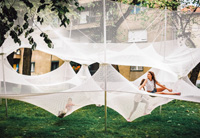 Net ZagrebPark 100. Brigade Hrvatske Vojske 16.06.-19.06.16.
Net ZagrebPark 100. Brigade Hrvatske Vojske 16.06.-19.06.16.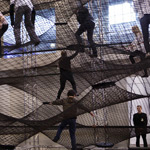 Net MoscowMay 2012
Net MoscowMay 2012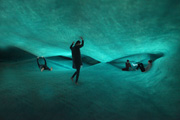 Tuft ParisPalais de Tokyo, Paris 2015.
Tuft ParisPalais de Tokyo, Paris 2015. Tuft RomeMacro Museum of Contemporary Art, 2013
Tuft RomeMacro Museum of Contemporary Art, 2013 Tuft PulaSv. Srca 09.-29.03.12.
Tuft PulaSv. Srca 09.-29.03.12. Tuft "Fluffy Harry"
Tuft "Fluffy Harry" Field ZagrebD-Day 15.-17.6.2012
Field ZagrebD-Day 15.-17.6.2012 N-Light Membrane 200Storage, Hyundai Card, 24.03.-16.07.17., South Korea
N-Light Membrane 200Storage, Hyundai Card, 24.03.-16.07.17., South Korea N-Light Membrane 100Rizzordi Art Foundation, Expression Beyond / 2011, St. Petersburg, Russia
N-Light Membrane 100Rizzordi Art Foundation, Expression Beyond / 2011, St. Petersburg, Russia N-Light ObjectsCube, Divided Cube, Octahedron, Tetrahedron, Trapezium
N-Light ObjectsCube, Divided Cube, Octahedron, Tetrahedron, Trapezium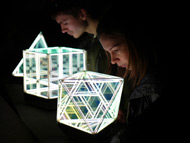 N-Light MilanExhibition at Zona Tortona / 2008
N-Light MilanExhibition at Zona Tortona / 2008 RigolettoTeatro Real / Madrid, 2023
RigolettoTeatro Real / Madrid, 2023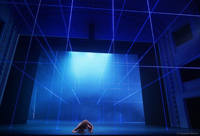 ErdeKomische Oper, Staatsballett Berlin, 2017
ErdeKomische Oper, Staatsballett Berlin, 2017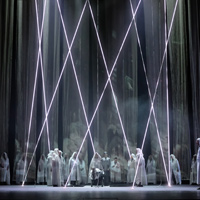 ParsifalNational Opera, Sofia 2017
ParsifalNational Opera, Sofia 2017 Alice in FearlandYugoslav Drama Theatre, Belgrade 2022
Alice in FearlandYugoslav Drama Theatre, Belgrade 2022 MountainsCullberg Dance Company, Stockholm 2021
MountainsCullberg Dance Company, Stockholm 2021 KraljevoDet Norske Teatret, Oslo 2018.
KraljevoDet Norske Teatret, Oslo 2018. Master and MargaritaNational Theatre Budapest, 2021
Master and MargaritaNational Theatre Budapest, 2021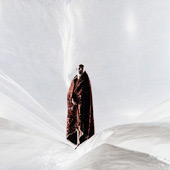 King LearPeiraios 260, Athens 2015
King LearPeiraios 260, Athens 2015 Black Beast SorrowCity Theatre MGL, Ljubljana 2013
Black Beast SorrowCity Theatre MGL, Ljubljana 2013 Don JuanNational Theatre Budapest, 2023
Don JuanNational Theatre Budapest, 2023 Symphony of Sorrowful SongsDeutsche Staatsoper Unter den Linden, Berlin 2010
Symphony of Sorrowful SongsDeutsche Staatsoper Unter den Linden, Berlin 2010 Zukunft braucht HerkunftBadisches Staatstheater Karlsruhe, 2019
Zukunft braucht HerkunftBadisches Staatstheater Karlsruhe, 2019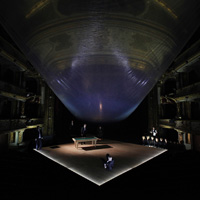 The WomanCroatian National Theatre, Zagreb 2016
The WomanCroatian National Theatre, Zagreb 2016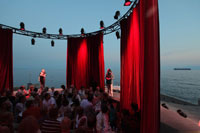 Circus DesteticaCroatian National Theatre Ivan Zajc, Rijeka 2010
Circus DesteticaCroatian National Theatre Ivan Zajc, Rijeka 2010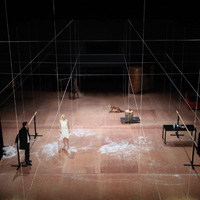 The CastleSlovene National Theatre of Drama, Ljubljana 2015
The CastleSlovene National Theatre of Drama, Ljubljana 2015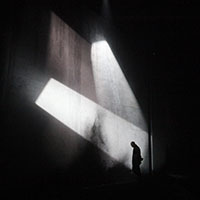 FaustCentro Dramatico Nacional / Valle-Inclan, Madrid 2014
FaustCentro Dramatico Nacional / Valle-Inclan, Madrid 2014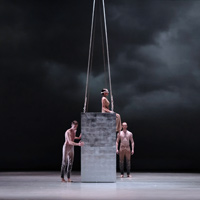 Dictionary of the KhazarsNational Theatre in Belgrade, 2018.
Dictionary of the KhazarsNational Theatre in Belgrade, 2018.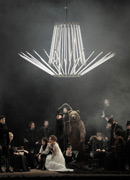 War and PeaceCroatian National Theatre, Zagreb 2011
War and PeaceCroatian National Theatre, Zagreb 2011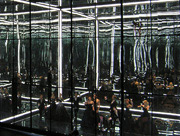 Inferno / Divine ComedyNational Theatre Maria Guerrero, Madrid 2005
Inferno / Divine ComedyNational Theatre Maria Guerrero, Madrid 2005 Chair in the DesertDocumentary / PQ 2011
Chair in the DesertDocumentary / PQ 2011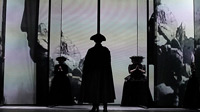 Dangerous LiaisonsSlovene National Theatre, Maribor 2012
Dangerous LiaisonsSlovene National Theatre, Maribor 2012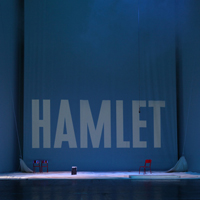 HamletYugoslav Drama Theatre, Belgrade 2016
HamletYugoslav Drama Theatre, Belgrade 2016 MedeaFestival Internacional de Teatro Clasico de Merida, 2009
MedeaFestival Internacional de Teatro Clasico de Merida, 2009 A Midsummer Night´s DreamGavella Drama Theatre, Zagreb 2008
A Midsummer Night´s DreamGavella Drama Theatre, Zagreb 2008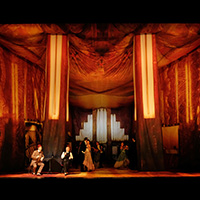 TeslaSlovene National Opera, Maribor 2022
TeslaSlovene National Opera, Maribor 2022 Balkan is not Dead (2013)Production design for a feature film, Skopje 2011
Balkan is not Dead (2013)Production design for a feature film, Skopje 2011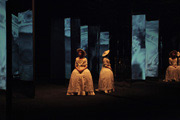 Dangerous LiaisonsHarbiye Muhsin Ertu?rul Sahnesi Theatre, Istanbul 2010
Dangerous LiaisonsHarbiye Muhsin Ertu?rul Sahnesi Theatre, Istanbul 2010 HamletMontenegrin National Theatre, 2019
HamletMontenegrin National Theatre, 2019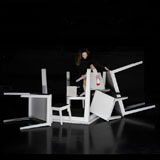 Boat for DollsSlovene National Theatre of Drama, Ljubljana 2009
Boat for DollsSlovene National Theatre of Drama, Ljubljana 2009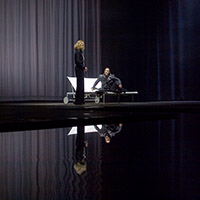 HamletMatadero / Madrid, 2009
HamletMatadero / Madrid, 2009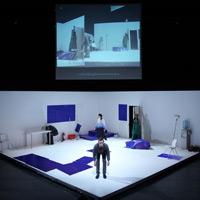 EuropaZKM, Zagreb Youth Theatre 2013
EuropaZKM, Zagreb Youth Theatre 2013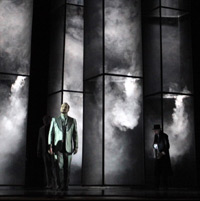 Black MasksSlovene National Opera, Maribor 2012
Black MasksSlovene National Opera, Maribor 2012 CinderellaCity Theatre Tresnja, Zagreb 2006
CinderellaCity Theatre Tresnja, Zagreb 2006 Nikola TeslaTeatro Nuovo Giovanni, Udine 2006
Nikola TeslaTeatro Nuovo Giovanni, Udine 2006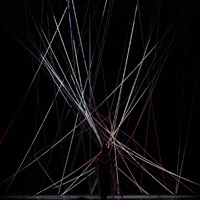 Twelfth NightCroatian National Theatre, Zagreb 2012
Twelfth NightCroatian National Theatre, Zagreb 2012 MethamorphosisYugoslav Drama Theatre, Belgrade 2010
MethamorphosisYugoslav Drama Theatre, Belgrade 2010 Quartett / BarrocoCentro Cultural de la Villa, Madrid 2007
Quartett / BarrocoCentro Cultural de la Villa, Madrid 2007 LayoutProstoria 2019
LayoutProstoria 2019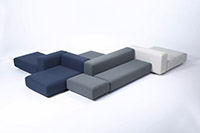 KlasterProducer: Prostoria 2021
KlasterProducer: Prostoria 2021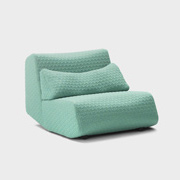 AbsentProducer: Prostoria 2019
AbsentProducer: Prostoria 2019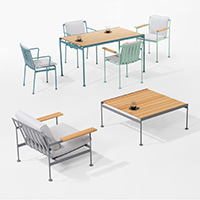 JugoProducer: Prostoria 2021
JugoProducer: Prostoria 2021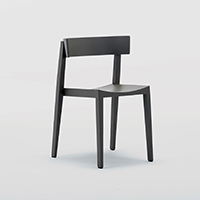 BikProducer: Prostoria 2020
BikProducer: Prostoria 2020 OblikantProducer: Prostoria 2018
OblikantProducer: Prostoria 2018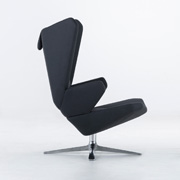 TrifidaeProducer: Prostoria 2017
TrifidaeProducer: Prostoria 2017 OsmoProducer: Prostoria 2017
OsmoProducer: Prostoria 2017 PolygonProducer: Prostoria 2014
PolygonProducer: Prostoria 2014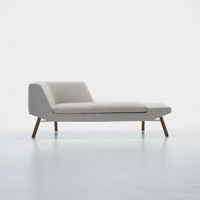 CombineProducer: Prostoria 2015
CombineProducer: Prostoria 2015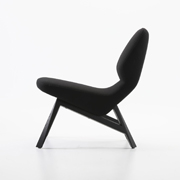 ObliqueProducer: Prostoria 2014
ObliqueProducer: Prostoria 2014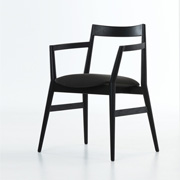 DobraProducer: Prostoria 2017
DobraProducer: Prostoria 2017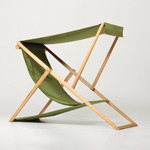 XZProducer: Element / 2010
XZProducer: Element / 2010 CUTProducer: Element / 2012
CUTProducer: Element / 2012 YYProducer: Moroso / 2011
YYProducer: Moroso / 2011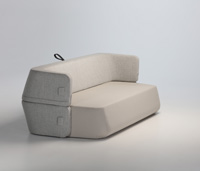 RevolveProducer: Prostoria 2012
RevolveProducer: Prostoria 2012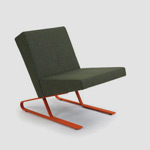 SatyrProducer: ClassiCon / 2006
SatyrProducer: ClassiCon / 2006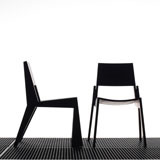 DamnedTheatre Matadero, Madrid / 2011
DamnedTheatre Matadero, Madrid / 2011 RRProducer: Element / 2010
RRProducer: Element / 2010 FKYProducer: Element / 2009
FKYProducer: Element / 2009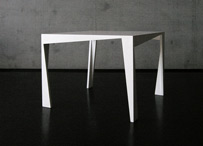 TwistProducer: Moroso / 2007
TwistProducer: Moroso / 2007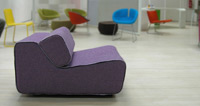 TransformProducer: Moroso / 2005
TransformProducer: Moroso / 2005 RivaProducer: L`Abbate / 2007.
RivaProducer: L`Abbate / 2007. SegmentProducer: Prostoria 2013
SegmentProducer: Prostoria 2013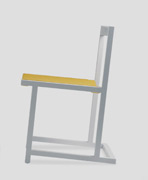 90°Producer: L´abbate / 2006
90°Producer: L´abbate / 2006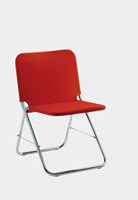 SMLXSProducer: Zanotta 2003
SMLXSProducer: Zanotta 2003 FU09Producer: MDF Italia / 2003
FU09Producer: MDF Italia / 2003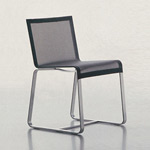 FU06Producer: MDF Italia / 2001
FU06Producer: MDF Italia / 2001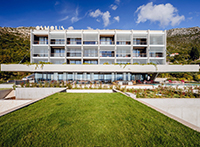 Hotel OsmolišBrsečine / Dubrovnik, Croatia 2021
Hotel OsmolišBrsečine / Dubrovnik, Croatia 2021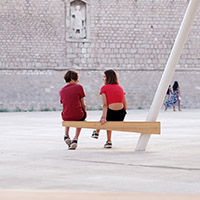 Poljana ŠibenikPoljana square, Šibenik 2020
Poljana ŠibenikPoljana square, Šibenik 2020 MontokucFire Lookout and Scenic Viewpoint, National Park Mljet, Croatia 2020
MontokucFire Lookout and Scenic Viewpoint, National Park Mljet, Croatia 2020 Hotel LoneRovinj, Croatia / 2011
Hotel LoneRovinj, Croatia / 2011 Waterfront SplitSplit, Croatia 2007
Waterfront SplitSplit, Croatia 2007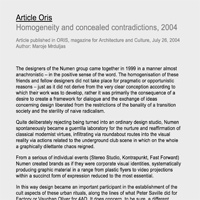 ArticlesOris 2003., Novi List 1999., Die Presse 2009.
ArticlesOris 2003., Novi List 1999., Die Presse 2009.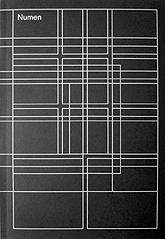 Retrospective exhibitionInstitute of Lexicography, Zagreb 2003
Retrospective exhibitionInstitute of Lexicography, Zagreb 2003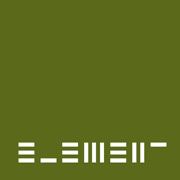 ElementFurniture Company
ElementFurniture Company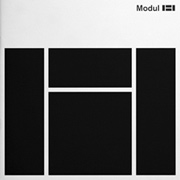 ModulExportdrvo, Zagreb 2002.
ModulExportdrvo, Zagreb 2002.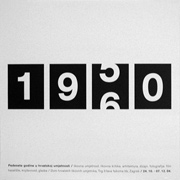 50´sHome of Croatian Visual Artists, Zagreb 2004.
50´sHome of Croatian Visual Artists, Zagreb 2004.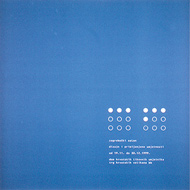 34. Zagreb SalonHome of Croatian Visual Artists, Zagreb 1999.
34. Zagreb SalonHome of Croatian Visual Artists, Zagreb 1999.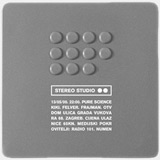 Stereo StudioZagreb, 1999. / 2000.
Stereo StudioZagreb, 1999. / 2000.